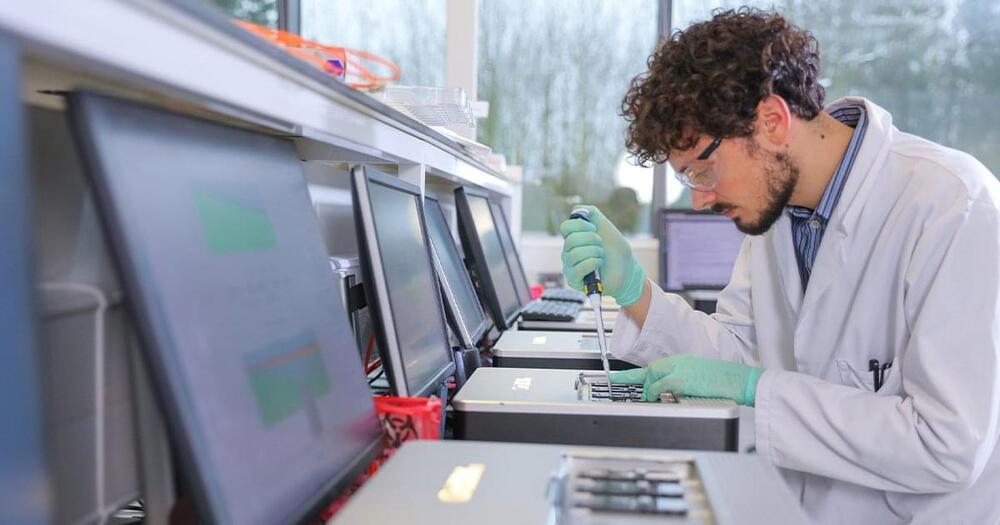Flying train Circa 2015.



Amazon announced Thursday that it plans to develop new technology for its autonomous delivery vehicles in Helsinki, Finland.
The Seattle-headquartered tech giant said in a blog post that it is setting up a new “Development Center” to support Amazon Scout, which is a fully electric autonomous delivery robot that is being tested in four U.S. locations.
Two dozen engineers will be based at the Amazon Scout Development Center in Helsinki initially, the company said, adding that they will be focused on research and development.

Researchers have finally sequenced the complete human genome, filling the gaps in the Human Genome Project’s (HGP) historic first draft.
“Having been part of the original Human Genome Project in 2001, and especially focused on the difficult regions, it’s really satisfying for me to see this done even though it took 20 years,” researcher Evan Eichler, a genome scientist from the University of Washington in Seattle, told New Scientist.
The human genome: A genome is like a genetic instruction manual — it contains all the information an organism needs to grow and function. The human genome is written in DNA, and while your exact genome is unique to you, about 99.9% of it is identical across all people.



SOCOM is using Other Transaction Authority (OTA) funds to partner with private biotech laboratory Metro International Biotech, LLC (MetroBiotech) in the pill’s development, which is based on what is called a “human performance small molecule,” he explained.
“These efforts are not about creating physical traits that don’t already exist naturally. This is about enhancing the mission readiness of our forces by improving performance characteristics that typically decline with age,” Hawkins said. “Essentially, we are working with leading industry partners and clinical research institutions to develop a nutraceutical, in the form of a pill that is suitable for a variety of uses by both civilians and military members, whose resulting benefits may include improved human performance – like increased endurance and faster recovery from injury.”
Hawkins said SOCOM “has spent $2.8 million on this effort” since its launch in 2018.


Over the past ten years, the number of known and named viruses has exploded, owing to advances in the technology for finding them, plus a recent change to the rules for identifying new species, to allow naming without having to culture virus and host. One of the most influential techniques is metagenomics, which allows researchers to sample the genomes in an environment without having to culture individual viruses. Newer technologies, such as single-virus sequencing, are adding even more viruses to the list, including some that are surprisingly common yet remained hidden until now. It’s an exciting time to be doing this kind of research, says Breitbart. “I think, in many ways, now is the time of the virome.”
SARS-CoV-2 is just one of nonillions of viruses on our planet, and scientists are rapidly identifying legions of new species.
Researchers from Baidu Research and the University of Maryland have developed a robotic excavator system that integrates perception, planning, and control capabilities to enable material loading over a long duration with no human intervention.

Micron pops the parachute.
Micron announced today that it has entered into a definitive agreement to sell its Lehi, Utah fab to Texas Instruments for $900 million in cash. In March, Micron announced that it planned to sell off the fab, bringing an end to its production of the radical new 3D XPoint (Optane) memory technology that it developed with Intel. Texas Instruments plans to deploy its own technologies at the site, meaning that it will not be used for 3D XPoint production. Intel currently doesn’t have any known high-volume production of the strategically important storage/memory media. However, it is known to produce a small amount of the media for research and validation at its New Mexico facility. As a result, Intel will likely have to establish its own production lines to ensure the supply of its Optane based SSDs and persistent memory DIMMs for its data center clients, though demand has seemed tepid.
Micron chose to exit 3D XPoint manufacturing due to lackluster demand that the company said had “insufficient market validation to justify the ongoing high levels of investments required to successfully commercialize 3D XPoint at scale.” The company recently divulged that it lost $400 million this year alone due to the lack of demand for 3D XPoint.
Micron has an agreement to produce 3D XPoint (which Intel brands as ‘Optane’) for Intel until the end of 2021. However, Intel’s own efforts to productize Optane, which uses the 3D XPoint media, have met with slow but steady uptake in the data center but fizzled in the consumer market. As such, Intel ceased production of all Optane devices for desktop PCs in January 2021.